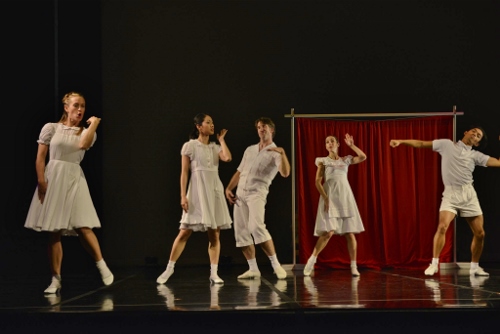|
 |
|
|
 |
 |
After a successful run in Cleveland at Playhouse Square’s Allen Theatre in October, Cleveland-based GroundWorks DanceTheater’s 2016 Fall Concert Series moved to nearby Akron and the Akron-Summit County Library. The program on November 18 opened with the latest work by GroundWorks’ artistic director David Shimotakahara entitled “Chromatic.” The 20-minute piece set to a suite of music by American composer Conlon Nancarrow (1912 –1997) was a stylistic departure for Shimotakahara in the type of movement he created for the troupe’s five dancers. Costumed in the colors of piano keys, the dancers engaged in a form of movement split personality. From the waist down, they adopted simple dance poses. From the waist up, they were a flurry of activity with hands and arms moving up and down and side-to-side seemingly without regard to rhythm. Shimotakahara’s unconventional choreography was a reaction to Nancarrow’s cacophony of player piano music that sounded like three different songs being played simultaneously. The effect of both the dance and music was unnerving yet compelling rejecting staid notions of dance as pleasantry. The work’s succession of solos, duets and group dancing found grace and a modicum of humor in sometimes stiff movement, dancers falling and the slapping of hands on thighs. Next former Hubbard Street Dance Chicago dancer Robyn Mineko Williams’ new commission for GroundWorks, “Part Way,” set a different tone. Danced to Rachmaninoff’s doleful “Trio Elégiaque No. 1 in G Minor,” Williams’ fluid choreography on the dancers cascaded like water tumbling over rocks in a gently flowing stream. GroundWorks’ five dancers touched, grasped, leaned into and folded over each in beautifully-crafted contemporary dance movement. Rachmaninoff’s music and Williams’ choreographic reaction to it, built a tension in the work that spilled out over the stage that was piqued by brief moments of distress and distraction displayed in the dancer’s demeanor. One such moment happened during an intertwining pas de deux danced by Felise Bagley and Damien Highfield in which Bagley, lifted above Highfield’s head, looked sharply about as if her name had been called out from somewhere off in the distance. Also of note in the piece, was a solo by Stephanie Terasaki in which she appeared to be pulled backward by her head by some unseen force. Her body undulated and gave into gravity and her momentum elegantly collapsed to the stage floor at times. With “Part Way,” Williams created a sophisticated dance work marrying finely crafted contemporary dance movement with emotional vulnerability and drama. It was performed deftly by GroundWorks’ dancers and is a work well worth revisiting by the company. On the subject of works worth revisiting, the program concluded with a revamped version of Pittsburgh-based dancer/choreographer Beth Corning’s “At Once There Was A House.” Created on GroundWorks in 2004, the funny and poignant dance-theater piece is one of Corning’s most memorable and best. Posing the question: Whatever happened to Dick and Jane? - those idealized elementary school educational icons used to teach children in the U.S. to read from the 1930’s through the 1970’s, “At Once There Was A House” catches up with a dysfunctional group of Dick and Janes who life has appeared to have done a number on. The setting for the dance-theater work was a reunion of sorts where this collection of stereotypical characters (jock, wallflower, prude) with some not-so-stereotypical emotional issues, paraded about to Tom Waits’ song “Table Top Joe” and spoke to the audience as if they were old acquaintances. Dancer Lauren Garson was the former homecoming/prom queen, Highfield, the bombastic former star athlete turned car salesman, Terasaki, a nervous shrinking violet, dancer Michael Marquez as a flamboyant character and Bagley as a prudish neat freak who scolded Marquez for his cartoonish pelvic gyrations, calling to him, “inappropriate.” Like a lyric from Waits’ song, “And I dreamed I'd be famous,” the characters appeared to regret in some way how their lives had turned out. Costumed in white schoolboy and schoolgirl-ish dresses and shorts, the audience got a glimpse into the lives of each of the characters via a series of vignettes that elicited a laugh or broke your heart. From Marquez poignantly dancing behind a life-size puppet in a skirt to a disillusioned Garson dancing a duet with a length of white picket fence and lamenting that the stereotypical American dream wasn’t all it was cracked up to be for her, “At Once There Was A House” touched that universal nerve called empathy. The most thoughtful, melancholy and gripping performance however belonged to Bagley, whose character’s anger and sorrow lay exposed like an open wound. In a most telling scene, Bagley, seemingly bereft of joy and happiness, set aflame a metal dollhouse, and true to her character’s nature it was a neatly controlled burn; one that perhaps symbolized the controlled burning rage and heartache within her.
 GroundWorks' Michael Marquez in Beth Corning's "At Once There Was A House." Photo © & courtesy of GroundWorks DanceTheater |
|
 GroundWorks' Michael Marquez in Beth Corning's "At Once There Was A House." Photo © & courtesy of GroundWorks DanceTheater |
|
 (L-R) GroundWorks' Lauren Garson, Stephanie Terasaki and Michael Marquez in David Shimotakahara's "Chromatic." Photo © & courtesy of Mark Horning |
|
 (L-R) GroundWorks' Lauren Garson, Michael Marquez and Stephanie Terasaki in Robyn Mineko Williams' "Part Way." Photo © & courtesy of Mark Horning |
|
 (L-R) GroundWorks' Lauren Garson, Stephanie Terasaki, Damien Highfield, Felise Bagley and Michael Marquez in Beth Corning's "At Once There Was A House." Photo © & courtesy of Mark Horning |
|
|
|






